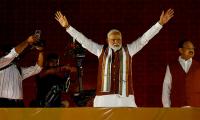Seventy-four years ago, the United States dropped the first atomic bomb over the city of Hiroshima, Japan. This nuclear weapon resulted in the deaths of an estimated 140,000 individuals. Three days later on August 9, a similar attack was carried out on the city of Nagasaki, Japan killing an additional 80,000 people.
These events changed history and made the US the most feared and ultimately most dangerous country in the world. That danger continues to this day as the new arms race unfolds.
Following World War II, the Cold War between the United States and the former Soviet Union resulted in our most immediate existential threat and the bloated nuclear stockpiles of today that contain 13,850 weapons.
The majority, 91 percent, of these weapons are controlled by these two countries with the rest in seven other nuclear states. Most of today’s weapons are many times more powerful than the Hiroshima and Nagasaki bombs.
For decades, arms control treaties have been the mainstay of efforts to contain and check the arms race and continue a dialogue with Russia and its predecessor, the Soviet Union. At the height of the Cold War there were in excess of 60,000 nuclear weapons.
This resulted from a false sense of security derived from the theory of deterrence where if my enemy had two weapon, I was safer with two and so on to 60,000 weapons! It was as though the superpowers existed together in a pool of gasoline and one had a single match and the other had one. There can be no winner!
The 1970 Nuclear Nonproliferation Treaty (NPT) committed the nuclear powers to work in “good faith” to eliminate nuclear weapons under Article VI.
In 1987, the Intermediate Nuclear Forces Treaty (INF), negotiated at the peak of the Cold War went into force. This landmark treaty eliminated an entire class of exceptionally dangerous weapons capable of immediate launch on warning and first strike capacities. In total, 2,692 short, medium and intermediate range nuclear missiles with a range of between 550- 5,500 km were eliminated.
The treaty which contains language to address concerns and compliance was terminated on August 2nd of this year when the United States withdrew from this treaty.
This move was just the latest by the Trump administration following on the withdrawal of the US last year from the multinational Iran Nuclear Deal.
Unfortunately, with this latest move coupled with others before, the United States has lost its credibility in arms control.
The new arms race began in 2011 as President Obama made his “grand bargain” when he agreed to modernize the US weapons arsenal in trade for needed Republican support to ratify the New Start Treaty.
This renewed arms race has been estimated to cost $1.7 trillion over the next 30 years with inflation.
And again with deterrence theory, each of the seven nuclear nations, not to be outdone is following suit in rebuilding their arsenals.
In January, the Bulletin of Atomic Scientists, identified the risk posed by nuclear weapons and climate change as the “new abnormal” announcing their Doomsday Clock setting at 2 minutes till midnight where midnight represents nuclear apocalypse, the closest at any point during the Cold War.
Excerpted from: 'Hiroshima and the New Arms Race—No Winners'.
Courtesy: Commondreams. org
After November 30, it will be impossible for ordinary internet users to access all banned websites, including X
Muslims participated alongside their Hindu fellow villagers and other residents of area
For last eight years, HEC's budget has been virtually stagnant in absolute terms
Home to 14 million people, Lahore has always been celebrated as Pakistan’s historical, culinary, and cultural hub
Partnership between Pakistan and China in media and culture reflects shared commitment to strengthening bilateral...
This article focuses on single error committed by our respected judiciary which haunts me more than I would care to...







